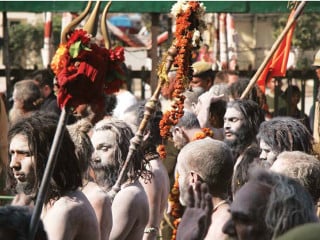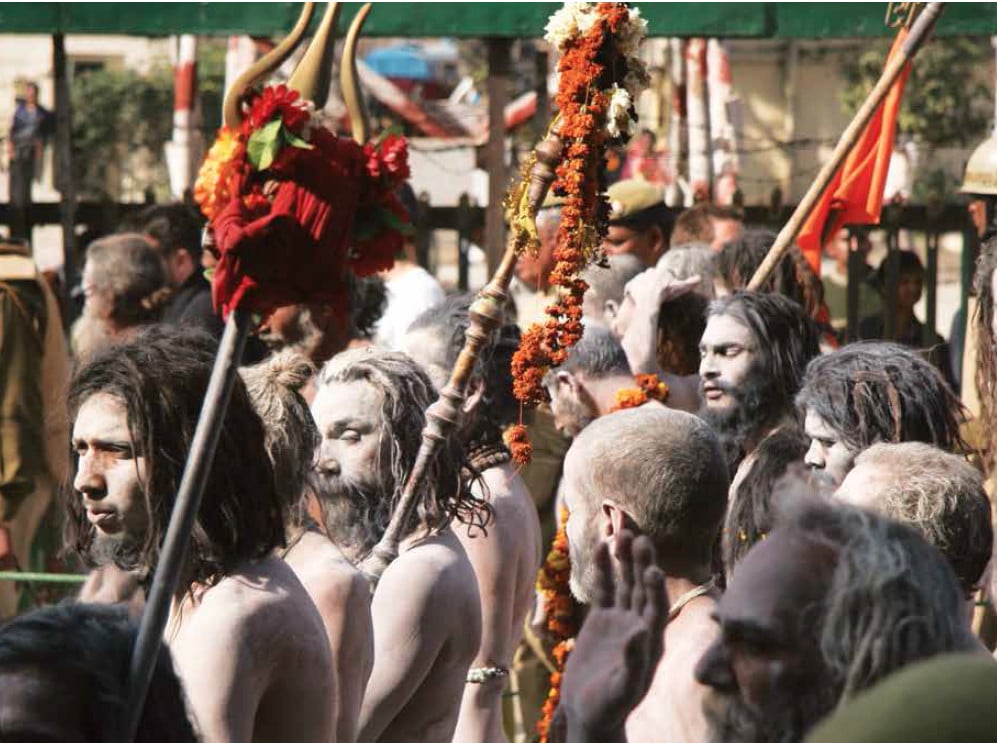1. Meaning, origin and expanse of the word ‘Akhada’
A. Meaning : ‘Akhada’ is a distorted form of the word ‘akhand’, which means complete organisation.
B. Origin : When the Jain, Buddhist and Muslim sects came into existence in Bharat, Hindu Dharma came under threat. Hence, in addition to the mission of imbibing knowledge, the Akhadas raised weapon-wielding brigades to repel the foreign invasions and named them Akhadas.
C. Expanse : The Ascetics of all sects, from North Bharat to Godavari River are classified into 13 Sanghas. The 13 Sanghas means 13 Akhadas.
Shaiva (Dashanami) Akhadas
There are seven such Akhadas.
| 1. Maha-nirvani | 2. Atal | 3. Niranjani |
| 4. Anand | 5. Juna (Bhairav) | 6. Avahan |
| 7. Agni |
Akhadas of the Shaiva sect
Adi Shankaracharya classified the united renunciants in the Shaiva sect into 10 groups.
| 1. Giri | 2. Puri | 3. Bharati | 4. Tirtha | 5. Ban |
| 6. Aranya | 7. Parvat | 8. Ashram | 9. Sagar | 10. Saraswati |
These united groups are called ‘Dashanami Akhadas’. These Akhadas are of seven types. The chief Deity and flag of each Akhada is different. Religious education and training in arms is given in the renunciant Akhadas of the Shaiva sect. Hence, they emit Kshatratej (Radiance of a warrior).
Vaishnav Akhadas
There are 3 prominent Akhadas.
| 1. Digambar | 2. Nirmohi | 3. Nirvani |
(There are 18 sub-Akhadas and khalsas.)
Akhadas of the Vaishnav sect
Some disciples of Jagad-guru Shri Ramanandacharya and the disciple of Shri Bhavanandacharya, Shri Balanandaji considered Prabhu Shriramchandra as their Deity of worship. They united all the four Vaishnav religious orders and established three Bairagi (Vaishnav) Akhadas. The Vaishnav Akhadas also practice weapons and study Holy scriptures vigorously.
Other Vaishnav Akhadas are –
| 1. Niralambi | 2. Santoshi | 3. Mahanirvani | 4. Khaki |
The Ascetics of these Akhadas call themselves ‘Bairagi’ or ‘Alakha’. The main duty of these Akhadas is to protect Hindus and their temples from the foreign aggressors.
Udasin Akhadas
There are two such Akhadas.
| 1. Udasin Panchayati Bada Akhada | 2. Udasin Panchayati Naya Akhada |
Besides these, Nirmal Akhada of Sikhs is also Udasin Akhada, which was established through the inspiration of their Dharmaguru Guru Gobind Singh.
Reason why the Akhadas of all Ascetics are only from North Bharat
All the Akhadas coming to the Kumbh Melas are from North Bharat. There is not a single Akhada from South Bharat. The utmost danger of attacks on Hindu Dharma was in North Bharat. Comparatively, South Bharat was calm. As a result, scholars following the Path of Knowledge are found in the South, whereas worshippers following the Path of Devotion are found in North Bharat.
2. The mission of Akhadas to protect Dharma
As the Hindu political powers became weak, the Ascetics and renunciants came forward to protect Dharma, so as to repulse the Islamic aggressors who heaped untold miseries on the Hindus. The Naga sect and Dashanami renunciants came together and held spears as a weapon which symbolised strength. They began to give training in gymnastics and using of various weapons such as swords, along with lessons on religious scriptures. Two parts – ‘The weapon-wielding renunciants who preserve the ancient spiritual traditions’ and ‘The weapon-wielding renunciants who fight for the protection of Dharma’ were created among the Naga-Dashanami renunciants. They performed the historic mission of protecting Dharma as given ahead.
A. In the year 1666, Aurangzeb attacked Ascetics and devotees in the Kumbh Mela at Haridwar. The Ascetics gave a fitting reply to the attack. When Maratha soldiers in the Mughal army noticed saffron flags of the Ascetics, they too fought against the Mughals. As a result, the Mughal army was defeated.
B. Innumerable Ascetics laid down their lives and repulsed the attack of Ahmadshah Abdali in 1748 and on Mathura in 1757.
C. The Mughal rule was eliminated from 32 villages in Jhansi under the leadership of Naga Ascetic Rajendragiri in from 1751 to 1753, and he hoisted the flag of Independence in these areas. In the Year 1751, Bangash Afghan chieftain Ahmed Khan of Farrukhabad resorted to violence and loot at Prayag, and abducted four thousand high-caste women. At that time, six thousand Naga Ascetics who had gathered at Triveni Sangam for the Kumbha Parva united and attacked the army of Bangash Afgan chieftain. The Ascetics freed the abducted women and wounded many Afghan soldiers.
D. In the Year 1855, during the Kumbh Mela at Haridwar, Oumanandji (Guru of Swami Dayanand Saraswati, Founder of Arya Samaj) and His Guru Purnanandji prepared a blue print for the First War of Independence against the British rulers in the Year 1857 and spread the blue print all over Bharat through the medium of Ascetics who had gathered from the entire country. During the Kumbh Mela at Prayag in the year 1858, Nanasaheb Dhundhu-pant, Balasaheb Peshwa, Tatya Tope, Ajmulla Khan and King Kunvarsingh of Jagadishpur took an oath in the camp of Dashanami Ascetics in the presence of ‘Dast’ Baba to drive the British out of Bharat. Hundreds of Ascetics and Saints were present for the oath-taking ceremony.
Not only renunciants, but Bairagis too fought with arms many times against aggressors of other religions, and thus performed a major duty in the protection of Dharma. Despite being scholars, the armed Ascetics of Shaiva and Vaishnav Akhadas gave great relief to the unarmed and peace-loving Hindu community. It is a historic fact that the aggression of Islam could be stopped on the border of Sindh due to these Akhadas.
3. Special features of the Akhadas
Almost all Ascetics associated with the Akhadas are experts in Holy scriptures as well as weapons.
4. Extraordinary internal aspects of Akhadas
A. All the Ascetics associated with an Akhada reside at one place in the Kumbh Mela, where they hold deliberations among themselves and plan for the future.
B. The Ascetics of Atal Akhada and Nirvani Akhada stay together during the Kumbh Mela, whereas those of the Anand Akhada and Niranjani Akhada stay together.
C. The renunciants who have performed spiritual practice for a minimum of 12 years or have acquired special spiritual powers get superior posts in the sectarian religious order.
D. The status of an Ascetic in an Akhada is decided after taking into account his spiritual ability and mental courage. While bestowing a status, there is no differentiating on the basis of caste or financial position.
E. Strict discipline is observed in the Akhadas. Ascetics who do not obey orders are given severe physical punishment or monetary fine.
F. There is a hierarchy of Mahamandaleshwar, Mandaleshwar, Mahant in each Akhada. The Brahmanishtha Ascetics, who are very humble, intelligent and have reached the state of Paramhansa are given these titles.
Reference : Sanatan Sanstha’s Holy Text, ‘Glory of the Kumbha Parva’




 Holy river
Holy river Bathing ghats located along Shipra River
Bathing ghats located along Shipra River Main Bathing Dates for Kumbha Parva at Haridwar 2021
Main Bathing Dates for Kumbha Parva at Haridwar 2021 Shahi snan meaning and importance
Shahi snan meaning and importance